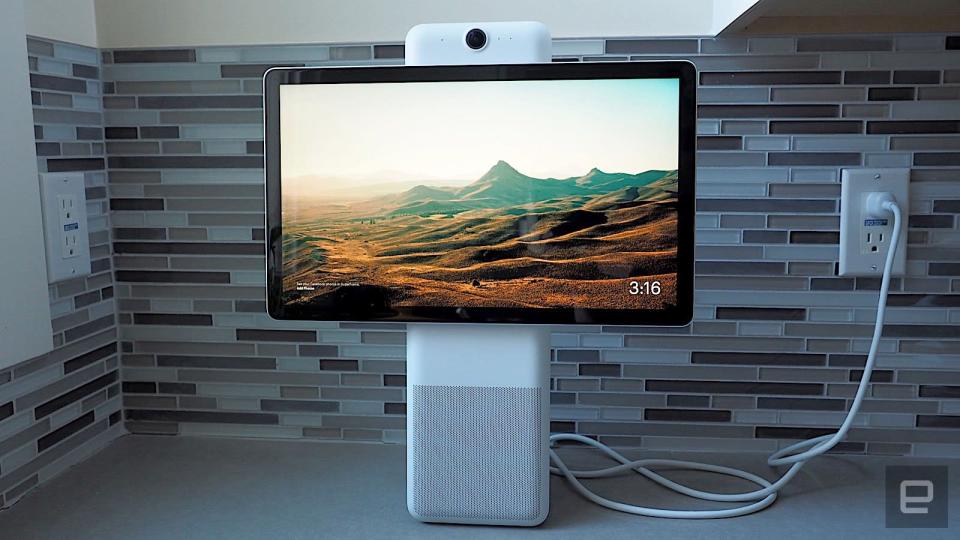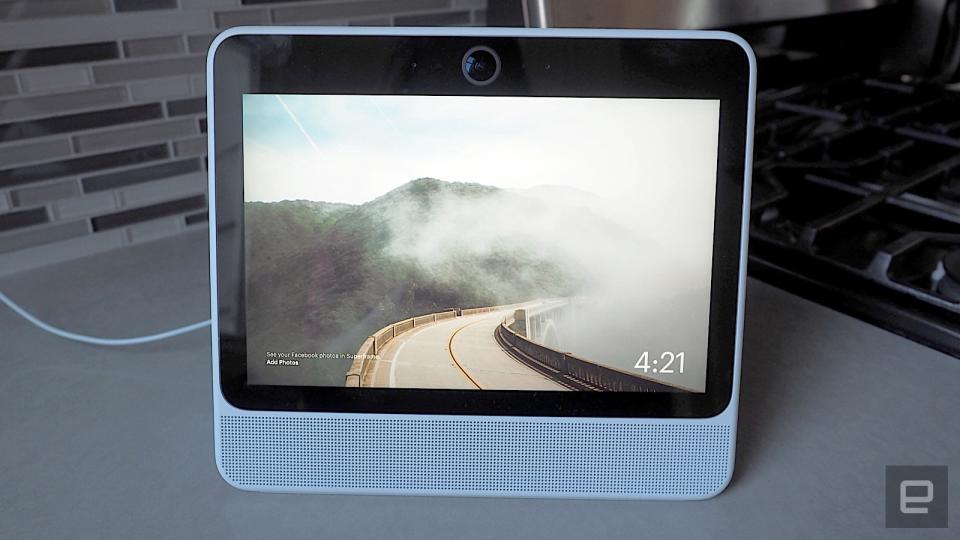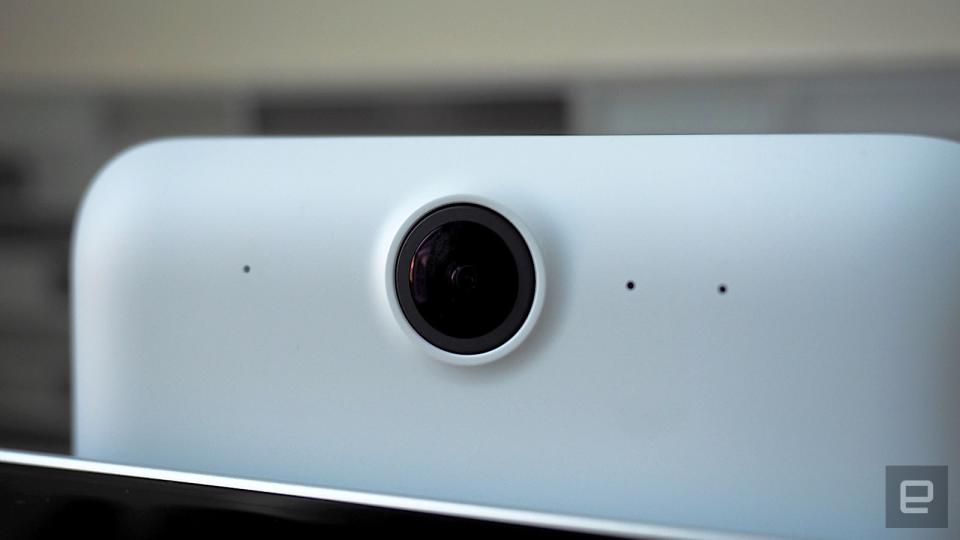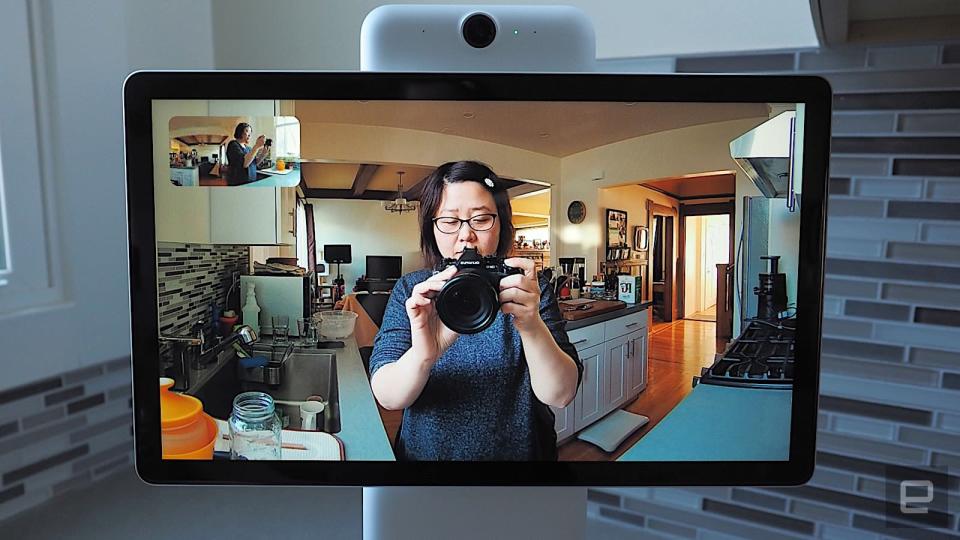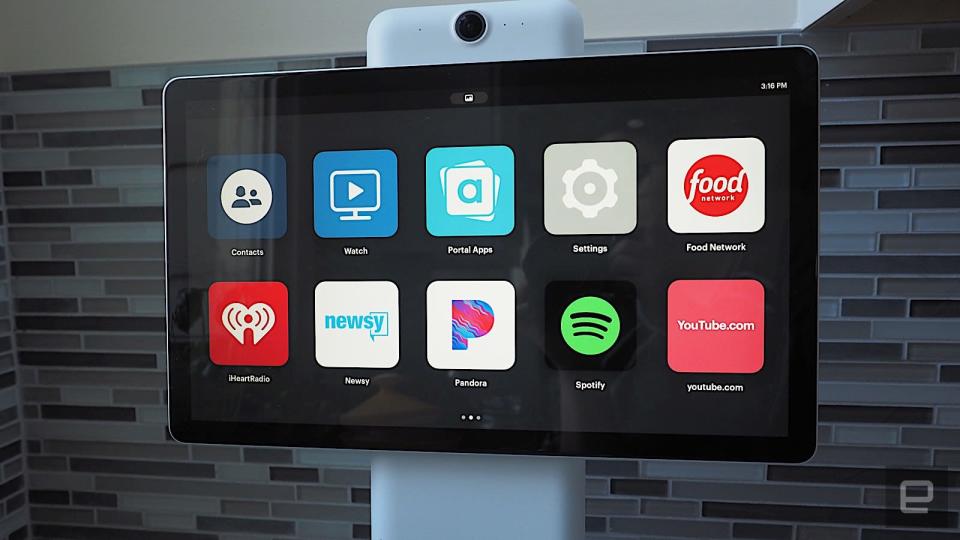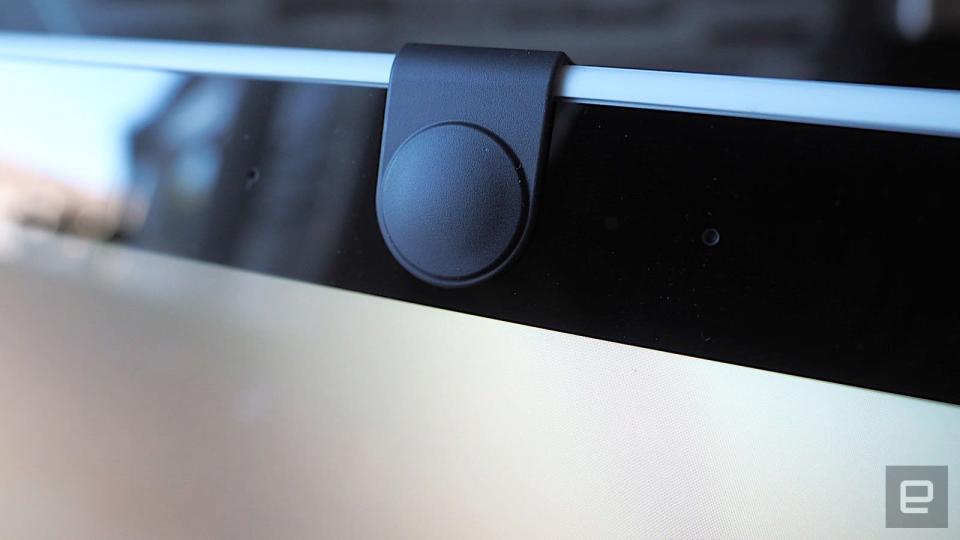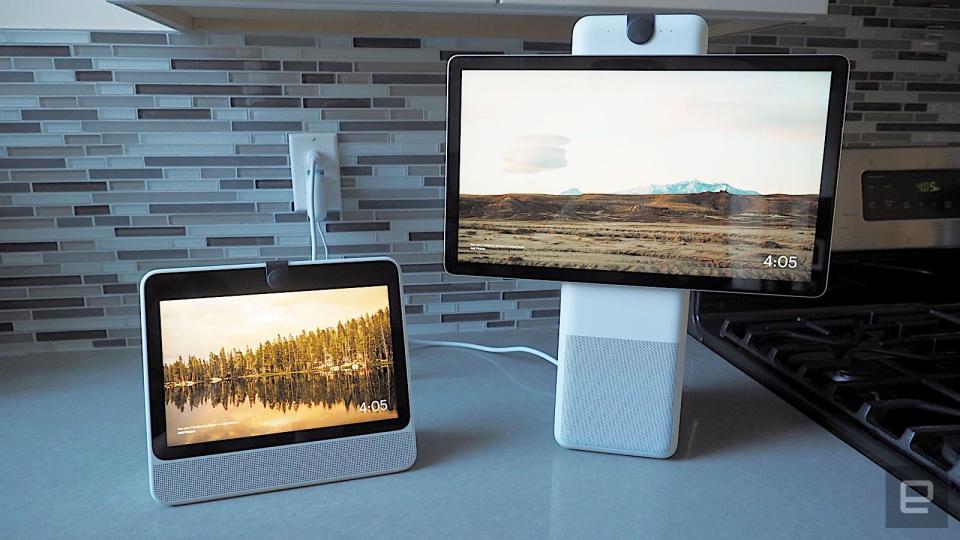Facebook Portal and Portal+ review: Video chat takes center stage
Smart camera algorithms follow your movements.
Facebook was set to launch Portal -- its first consumer hardware -- at this year's F8 developer conference. However, with the Cambridge Analytica scandal still fresh in people's minds, the company, perhaps wisely, opted to introduce its connected cameras for the home instead. While Facebook hasn't exactly mended its reputation, the Portal and the Portal+ are finally ready for their public debut. The key feature with both Portals is a smart camera algorithm that follows you around the room as you're talking. It's not a bad idea, and I like that there are other features like apps and Alexa, making both Portals viable Echo Show rivals. The question remains, however, whether or not you deem Facebook to be trustworthy enough to have a Portal in your home. First, I'll go over the differences between the two Portals. The "normal" $199 Portal has a 10-inch screen and looks similar to Amazon's Echo Show except it's white instead of black and the speakers are underneath the display (instead of behind it). Then there's the $349 Portal+, which has a large 15.6-inch display that rotates from landscape to portrait mode. Both have decent displays with good color and contrast -- the smaller Portal has a 1,280 x 800 resolution while the larger Portal+ is 1,920 x 1080. The Portal+ obviously takes up way more room, which I found to be pretty overwhelming. It barely fits between my kitchen counter and cabinets, and when it's in landscape mode it doesn't leave a lot of room on either side for other countertop items. I also think it's pretty ugly. For a device that's supposed to be part of your home, it sticks out like a sore thumb. If I had to choose a Portal based on design alone, I would definitely opt for the Portal over the Portal+. The larger Portal+ certainly has better video quality, and the portrait mode is useful in some instances (I'll get to that shortly), but I'm not sure if the tradeoff is worth it. Other smart displays like Amazon's Echo Show and the Lenovo Smart Display offer video chat, so the idea behind Portal isn't new. The two Portals, however, step it up with several features that make video chat the focus, rather than an afterthought. For one thing, it works with Messenger, which already has millions of users. Another is that the software and camera are designed to enhance conversations by following whoever's talking. Before we get into that, though, let's talk about setup. I tested the Portal+ with my colleague Roberto Baldwin, who used the regular Portal. Obviously, the first step was to set it up with my Facebook account, which involved going to the Facebook app while the Portal was in pairing mode. You have the option to set up as many as four accounts, ostensibly for each person in your home, so you can switch between via settings. After that, the Portal automatically pulled in all my contacts, which allowed me to add them to my Favorites list. Because it's one of the first things you see when you wake the device, it's much easier to call your Favorites. Additionally, when someone on your Favorites list comes online, the Portal will beep to let you know. To make a call, you select the person's profile photo or use Portal's voice assistant (more on that later). For example, I could say "Hey, Portal, call Roberto Baldwin" from across the room instead of having to tap the screen. As with the Messenger app, you can set your availability status to be on or off whenever you like. The Portals also have a Home/Away function, so that it only rings when you're home and goes into standby mode when you're out of the house. It sets this automatically based on the geolocation of your phone. The key feature of both the Portal and Portal+ is the 12-megapixel camera that sits above the display. During calls with Roberto, I tapped the picture-in-picture mode so I could see how I looked on camera as well. I was impressed with the wide 140-degree field of view, which captured my entire open-concept kitchen and living room in a single screen. I imagine this is especially useful when you're chatting with large groups of people, as everybody can likely be in the shot at once. More important, the cameras use AI and algorithms to track your movements, keeping you perfectly in the frame as you walk around the room. Despite my initial skepticism about this, I have to admit it was really impressive. The shot pans around, zooming in and out, almost like a professional cinematographer, and I was never out of frame no matter how much I pranced around. It even followed me when I crouched on the floor. Flip the Portal+ screen to portrait mode and the shot automatically reframes to center on just the other person, making it perfect for one-on-one calls (more on that below). It's especially ideal if the other person is on a phone, as most people hold their phones vertically to chat anyway. I'll admit, the movements were so smooth that it verges on a little creepy, as if the camera lens was physically following me around. However, it remains perfectly still -- all of that aforementioned tracking is done with software. This really comes into play in Spotlight mode, which is a way to focus on a specific person (when there are multiple people in a room). Simply double-tap on a person's face, and the Portal automatically zooms in on them, following their head movements as they move and speak. I can see how this is especially useful for keeping track of fidgety kids. I'm fairly disappointed, however, that Spotlight mode doesn't seem to work on dogs or cats. It's also a surprisingly refreshing way to have a video chat. Instead of being held captive by the hardware, you're free to go about your daily life, preparing dinner or chasing after the dogs, without losing the person on the other line. I naturally found myself walking around the kitchen to put away the dishes or just grabbing a bite to eat. Facebook says that one of the ideas behind Portal is to make it feel like the person is right there in the same room as you, and I definitely felt that. Of course, if you don't want the camera following you around, you can enable Fixed Camera view, which keeps the screen in a fixed shot. There are a few other cute video-chat features, like augmented-reality filters that overlay your face or environment with amusing effects. Another is StoryTime, which lets you tell a dramatic story with the help of teleprompter text, complete with animations, graphics and sound on the recipient's end. This is clearly meant for entertaining kids. Another neat trick is the option to listen to Spotify tunes together. If you want to share a song with your friend, you can tap Spotify, play a song and you'll both hear it at the same time. There's even smart noise-canceling tech to handle the song volume separately, so you can pump up the volume to the max on your end, while your friend can lower it on theirs. I tried this out with Roberto, and it worked as promised. Yet I have to wonder if anyone actually does this in real life -- I don't remember the last time I shared a song I liked over the phone when I could just shoot them a URL. Both Portals support groups calls of up to seven people. I tried this with Roberto on the Portal and a couple of other colleagues on the Messenger app on their phones. You can add people to an existing call by selecting them from your Contacts list. Once they answered, all of them appeared on my screen at once, sort of like the opening credits of The Brady Bunch. The larger screen on the Portal+ really comes into use here, as I liked being able to see everyone's faces on such a big display. You can also transfer calls between Portal and your phone's Messenger app. Simply tap the "Transfer call from [contact]" notification on your phone (if transferring from Portal to phone) or select the transfer icon on the top right corner of the app (if doing it the other way round). When not on a call, the Portals can be used as smart displays. They come with several apps, such as Newsy, Pandora, Spotify, YouTube, Food Network and Facebook Watch, with more to come. But the app experience isn't perfect. The YouTube app, which is essentially just a browser shortcut to YouTube.com, doesn't have an intuitive interface. Scrolling through the videos, for example, resulted in stuttery clicks instead of smooth swipes. The Food Network app seems like a good idea, as it replicates the cooking guides found on other smart displays, but it lacks essentials like ingredients lists and step-by-step instructions. Plus, there's no Search function, so I can't even look up a specific recipe. What makes things confusing is that the Portal and Portal+ come with two voice assistants. There's "Hey Portal," which is used for device controls and calls, and Amazon's Alexa, which is used for other functions. If you want to make calls, you have to use "Hey Portal." But when you want to play Spotify, ask for the weather, set a timer and so forth, you have to use Alexa. "Hey Portal" can also be used for Facebook-specific services. For example, I could say "Hey Portal, play Facebook Watch" to launch the social network's streaming-video service. For some reason, however, I can't use Alexa to do so. In fact, neither Alexa nor "Hey Portal" work with some of the aforementioned apps, like YouTube or Food Network. I found it all a little perplexing and mixed the two voice assistants up constantly during my testing. That said, the collaboration between Facebook and Amazon isn't final. According to Facebook, Portal has incorporated Amazon's Smart Display SDK, and the companies are working closely to improve the experience on the Portal and Portal+. Plus, access to Prime Video and other Amazon services are coming in 2019. As far as sound quality goes, it's not great, but it's not terrible. The Portal+ comes with 20-watt speakers plus a 4-inch sub, so it sounds slightly better than the Portal, which has only 10-watt speakers. Of course, neither are as good as dedicated speakers like Sonos, and they're not quite as powerful as the latest Echo Show. Still, both had loud, punchy volume and decently crisp audio. I wouldn't use them as my primary devices for listening to music, but they certainly work in a pinch. Last but not least, we have to talk about privacy. There's a button on both Portals that shuts off both the camera and the microphone via an electronic switch. Both also come with a physical camera lens cover if you're feeling extra paranoid or if you want to shut the camera off but still want to use the microphone for voice functions. I did wish that the camera lens cover was built in to the hardware instead of being a separate piece of plastic that I might lose, but it's better than not having one. You can also set up a passcode so your kids can't make random calls to your friends. According to Facebook, all of the video chats are encrypted and the company doesn't listen, view or keep records of your calls. The AI on the camera and voice features are run locally, not on Facebook's servers. Though the camera does use the shape of your face and voice to track your movements, there's no facial-recognition technology at work here -- it can't differentiate between your face and someone else's, for example. Like on Amazon's Echo devices, your voice history is stored online, but you can delete it manually. You can delete your Portal's voice history by going to your Facebook Activity Log, and Alexa history can be deleted by going into the Alexa app. But not everything is as it seems. Over a week after Portal's announcement, Facebook said the company does collect some types of information from video chats, such as usage data like length and frequency of calls, and that that information could be used to serve you ads. Facebook's business model is based on advertising, so this isn't exactly surprising. But the fact that the company wasn't forthcoming about this is a little concerning. When you add to that the recent massive data breach of as many as 50 million users along with the Cambridge Analytica scandal, I have to admit that I'm a little wary of it. Of course, that's not to say that Amazon products haven't been accused of listening in on people's homes, either, and it's a risk that every consumer has to keep in mind when investing in a smart speakers. It's all about whether you trust that your data is safe with these companies. Unfortunately for Facebook, it hasn't done a lot to earn anyone's trust lately. Facebook's Portal line is not a bad idea; a smart display that puts video chat at the forefront is pretty clever, and though it's a little creepy, a camera that follows you around adds to a sense of social presence with someone even if they're far away. Other features like YouTube and Alexa integration are great too, as they make it more of an Echo Show rival. At the same time, however, it doesn't quite match up to other smart displays. It doesn't have a step-by-step cooking guide, there's no built-in browser like on the Echo Show, and you can't use it to view the feed from your home-security cameras. Not to mention that having two voice assistants is really confusing, and not all of Amazon's Smart Screen features are here. If you and your family rely on Messenger for communications, I can see giving Portal a shot. In that case, I would recommend the cheaper and smaller Portal, which costs $199; $349 for the larger Portal+ is a little too much money, and I don't think it's practical for most people. In the end, however, it's up to you whether you trust Facebook enough to have one of its cameras in your home. Update: At Engadget, we take our reviews seriously. Occasionally, we may revise our initial score based on news and events that change our overall view. We've updated the score of this product to better represent the concerns over how Facebook handles your data.
